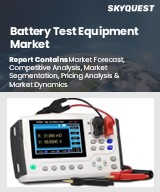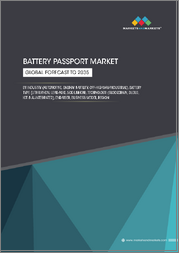
|
시장보고서
상품코드
1569868
세계의 미래 배터리 시장 전망(-2030년) : 배터리 유형, 전압, 구성요소, 기술 발전, 용도, 최종 사용자, 지역별 분석Future of Batteries Market Forecasts to 2030 - Global Analysis By Battery Type, Voltage, Component, Technological Advancement, Application, End User and By Geography |
||||||
Stratistics MRC에 따르면 미래 배터리 세계 시장은 2024년 178억 7,000만 달러에 이르고, 예측 기간 동안 13.5%의 연평균 복합 성장률(CAGR)로 성장하여 2030년에는 382억 1,000만 달러에 달할 것으로 예상됩니다.
미래 배터리 시장에는 에너지 밀도, 수명, 충전 속도 및 안전 기능을 향상시키기 위해 설계된 혁신적인 배터리 기술의 발전과 상용화가 포함됩니다. 전기자동차와 재생 가능 에너지의 보급이 증가함에 따라 이 분야는 지속가능성을 중요시하게 될 것입니다. 이러한 기술에 대한 추가 연구 및 투자로 인해 환경 친화적이고 효율적인 에너지 환경을 실현할 수 있을 것으로 기대되며, 성능 향상과 가격 하락도 예상됩니다.
국제에너지기구(IEA)에 따르면 2023년에는 전 세계에서 소비되는 자동차의 약 18%가 전기차가 될 것이며, 2022년 14%에서 2023년에는 매주 25만대 이상의 전기차가 새로 등록될 것으로 예상됩니다. 이러한 추세는 세계 배터리 시장의 미래에 큰 성장 잠재력을 보여주고 있습니다.
전기차(EV) 수요 증가
배터리 수요 증가는 대부분 전기자동차에 의한 것입니다. 고성능 배터리는 전기자동차(EV)의 추진력에 필수적이며, EV의 보급이 증가함에 따라 배터리 수요도 증가할 것입니다. 온실가스 배출을 줄이고 대기 질을 개선하기 위해 전 세계 정부가 전기차 도입을 장려하면서 배터리 시장은 빠르게 성장하고 있습니다. 자동차 업계는 배터리 성능 향상과 비용 절감을 위해 전기차 연구와 배터리 기술에 많은 투자를 하고 있습니다.
높은 생산 비용
특히 나트륨 이온 배터리나 고체 배터리와 같은 첨단 배터리 기술에서는 높은 제조 비용이 큰 걸림돌로 작용하고 있습니다. 비용 증가는 복잡한 제조 절차, 고유한 재료, 성능 향상에 필요한 지속적인 연구로 인해 발생합니다. 제조업체는 가격과 품질 사이에서 균형을 맞추어야 하기 때문에 이러한 비용이 보급을 방해할 수 있습니다. 또한, 코발트나 리튬과 같은 원자재 가격의 변동은 제조 비용을 증가시켜 개발 중인 배터리 기술의 전반적인 수익성과 확장성에 영향을 미칠 수 있습니다.
가전제품 사용량 증가
스마트폰, 노트북, 웨어러블 기기 등 가전제품의 보급도 배터리 시장 확대의 중요한 요인입니다. 이러한 전자기기는 충전식 배터리에 의존하고 있으며, 보급이 확대되고 기능이 풍부해짐에 따라 배터리에 대한 수요가 증가하고 있습니다. 소비자들이 무선 및 휴대용 전자기기를 선호하고 충전 시간이 짧고 수명이 긴 배터리를 요구함에 따라 배터리 시장이 확대되고 있습니다.
대체 에너지 저장 솔루션과의 경쟁
추가 에너지 저장 옵션과의 경쟁은 큰 장애물입니다. 압축 공기 시스템, 플라이휠 에너지 저장, 슈퍼커패시터와 같은 기술을 사용하면 유지 보수 비용 절감, 수명주기 연장, 빠른 충전 및 방전 속도 등 몇 가지 이점이 있습니다. 이러한 대체 기술이 대중화되고 가격이 더 저렴해지면 자금과 고객의 관심이 기존 배터리 기술에서 집중되어 기존 배터리 기술에서 벗어날 수 있습니다. 이러한 경쟁은 배터리 성능, 효율성 및 비용에 대한 끊임없는 혁신을 요구하며, 시장에서의 입지를 유지하기 위해 이러한 경쟁은 계속될 것입니다.
COVID-19의 영향
코로나19는 시장에 큰 영향을 미쳤고, 폐쇄와 제한으로 인해 공급망과 제조 공정이 혼란에 빠졌습니다. 특히 배터리 의존도가 높은 첨단 재생에너지 시스템과 전기자동차의 경우, 프로젝트와 생산 일정이 지연되었습니다. 그러나 국가와 기업이 복구 노력에서 지속가능성을 우선순위에 두면서, 이번 위기는 청정에너지로의 전환을 가속화했습니다. 의료기기, 원격 근무 기술 등 배터리 구동 제품에 대한 수요가 증가함에 따라 내결함성 배터리 솔루션은 특히 중요합니다.
예측 기간 동안 전기자동차(EV) 분야가 가장 큰 비중을 차지할 것으로 예상됩니다.
전기차(EV) 부문은 예측 기간 동안 가장 큰 시장 점유율을 차지할 것으로 예상되며, 친환경 교통수단에 대한 고객의 관심 증가와 배터리 기술의 비약적인 발전으로 인해 EV는 점점 더 매력적으로 변모하고 있습니다. 고체 배터리와 같은 기술의 발전은 주행거리 불안 문제를 완화하고 EV의 채택을 촉진하며, 더 빠른 충전, 더 나은 안전성을 제공합니다. 정교한 배터리 솔루션에 대한 수요는 청정 이동성을 촉진하고 전기자동차로의 전환을 더욱 가속화할 수 있는 정부 규제와 인센티브에 의해 더욱 촉진될 것입니다.
예측 기간 동안 가장 높은 CAGR을 나타낼 것으로 예상되는 주거 부문
주택 부문은 에너지 독립성과 지속가능성에 대한 수요 증가로 인해 예측 기간 동안 큰 폭의 성장이 예상됩니다. 태양광 발전 설비를 보완하기 위해, 더 많은 가정이 전력 피크 및 정전 시 사용할 수 있는 잉여 에너지를 저장할 수 있는 축전지 시스템을 설치하는 경우가 증가하고 있습니다. 또한, 전기 요금의 상승과 환경에 대한 인식이 높아짐에 따라 소비자들은 에너지 효율이 높은 솔루션에 대한 투자를 늘리고 있습니다.
가장 큰 점유율을 차지하는 지역 :
북미는 전기자동차의 빠른 보급, 재생 가능 에너지 저장에 대한 수요 증가, 배터리 기술의 지속적인 발전으로 인해 예측 기간 동안 가장 큰 시장 점유율을 차지할 것으로 예상됩니다. 또한, 이 지역에서는 지속가능성에 대한 관심이 높아지고 있으며, 청정 에너지 솔루션에 대한 정부 보조금 지원도 시장 성장에 기여하고 있습니다. 또한, 북미의 주요 자동차 및 배터리 제조업체들은 차세대 배터리 기술에 대한 투자와 혁신을 장려하고 있습니다.
CAGR이 가장 높은 지역 :
예측 기간 동안 유럽이 가장 높은 CAGR을 보일 것으로 예상됩니다. 이 시장은 배터리 기술에 대한 막대한 투자와 지속가능성에 대한 강한 의지를 바탕으로 성장하고 있습니다. 발전의 주요 원동력 중 하나는 전기자동차의 보급이며, 이는 탄소 배출량 감소를 목표로 하는 정책에 의해 촉진되고 있습니다. 효과적인 에너지 저장 솔루션의 필요성은 재생 가능 에너지의 성장으로 인해 더욱 강화되고 있으며, 이는 정교한 배터리에 대한 수요를 증가시키고 있습니다.
무료 맞춤형 서비스 :
이 보고서를 구독하는 고객은 다음과 같은 무료 맞춤화 옵션 중 하나를 사용할 수 있습니다.
- 기업 프로파일
- 추가 시장 기업의 종합적인 프로파일링(최대 3개사까지)
- 주요 기업의 SWOT 분석(최대 3개사)
- 지역 세분화
- 고객의 관심에 따른 주요 국가별 시장 추정치, 예측, CAGR(주: 타당성 확인에 따라 다름)
- 경쟁사 벤치마킹
- 제품 포트폴리오, 지리적 입지, 전략적 제휴를 기반으로 한 주요 기업 벤치마킹
목차
제1장 주요 요약
제2장 서문
- 개요
- 이해관계자
- 조사 범위
- 조사 방법
- 데이터 마이닝
- 데이터 분석
- 데이터 검증
- 조사 접근
- 조사 정보원
- 1차 조사 정보원
- 2차 조사 정보원
- 전제조건
제3장 시장 동향 분석
- 성장 촉진요인
- 성장 억제요인
- 기회
- 위협
- 기술 분석
- 용도 분석
- 최종사용자 분석
- 신흥 시장
- COVID-19의 영향
제4장 Porter의 Five Forces 분석
- 공급 기업의 교섭력
- 바이어의 교섭력
- 대체품의 위협
- 신규 진출업체의 위협
- 경쟁 기업간 경쟁 관계
제5장 세계의 미래 배터리 시장 : 배터리 유형별
- 리튬 이온 배터리
- 나트륨 이온 배터리
- 해수 배터리
- 고체 배터리
- 납축전지
- 니켈 수소(NiMH) 배터리
- 아연 공기 배터리
- 플로우 배터리
- 기타 배터리 유형
제6장 세계의 미래 배터리 시장 : 전압별
- 저전압(2V 미만)
- 중전압(2V-5V)
- 고전압(5V 이상)
제7장 세계의 미래 배터리 시장 : 컴포넌트별
- 전해질
- 액체
- 고체
- 겔
- 애노드 재료
- 흑연
- 실리콘
- 나트륨
- 캐소드 재료
- 리튬 코발트 산화물
- 니켈 망간 코발트
- 세퍼레이터
제8장 세계의 미래 배터리 시장 : 기술별
- 기존 배터리 기술
- 차세대 배터리 기술
- 재활용과 세컨드 라이프 응용
- 배터리 관리 시스템(BMS)
- IoT 통합형 스마트 배터리
- 기타 테크놀러지
제9장 세계의 미래 배터리 시장 : 용도별
- 전기자동차(EV)
- 에너지 저장 시스템
- 가전
- 스마트폰
- 노트북
- 태블릿
- 산업 용도
- 지게차
- 백업 전원
- 의료기기
- 항공우주 및 방위
- 통신
- 휴대용 전동 공구
- 기타 용도
제10장 세계의 미래 배터리 시장 : 최종사용자별
- 주택
- 상업
- 운송
- 제조업 및 중공업
- 유틸리티
- 기타 최종사용자
제11장 세계의 미래 배터리 시장 : 지역별
- 북미
- 미국
- 캐나다
- 멕시코
- 유럽
- 독일
- 영국
- 이탈리아
- 프랑스
- 스페인
- 기타 유럽
- 아시아태평양
- 일본
- 중국
- 인도
- 호주
- 뉴질랜드
- 한국
- 기타 아시아태평양
- 남미
- 아르헨티나
- 브라질
- 칠레
- 기타 남미
- 중동 및 아프리카
- 사우디아라비아
- 아랍에미리트(UAE)
- 카타르
- 남아프리카공화국
- 기타 중동 및 아프리카
제12장 주요 발전
- 계약/파트너십/협업/합작투자(JV)
- 인수와 합병
- 신제품 발매
- 사업 확대
- 기타 주요 전략
제13장 기업 프로파일링
- Tesla, Inc.
- Contemporary Amperex Technology Co., Ltd.(CATL)
- LG Energy Solution
- Samsung SDI
- Panasonic Corporation
- BYD Company Limited
- Northvolt
- QuantumScape
- Solid Power
- Faradion Ltd.
- AquaBattery
- Svolt Energy Technology
- Natron Energy
- Amprius Technologies
- Zinc8 Energy Solutions
- Toshiba Corporation
- BASF
- Lyten
- Redflow Limited
- Nextera Energy
LSH 24.10.24
According to Stratistics MRC, the Global Future of Batteries Market is accounted for $17.87 billion in 2024 and is expected to reach $38.21 billion by 2030 growing at a CAGR of 13.5% during the forecast period. The future of the batteries market involves the advancement and commercialization of innovative battery technologies designed to enhance energy density, lifespan, charging speed, and safety features. As electric vehicles and renewable energy sources become more and more popular, this sector is defined by a strong emphasis on sustainability. An eco-friendly and more efficient energy landscape is anticipated as a result of further research and investment in these technologies, which are also predicted to improve performance and lower prices.
According to the International Energy Agency, around 18% of cars consumed in the world will be electric in 2023, a rise from 14% in 2022. More than 250,000 new e-vehicle registrations will be made weekly in 2023. This trend is showcasing significant growth potential for the global future of the battery market.
Market Dynamics:
Driver:
Growing demand for electric vehicles (EVs)
The increasing need for batteries is mostly due to electric modes of transportation. High-performance batteries are essential to the propulsion of electric cars (EVs), and as EV adoption rises, similarly will battery demand. The market for batteries is expanding faster because governments all over the world are encouraging the adoption of EVs to cut greenhouse gas emissions and enhance air quality. The automotive sector is making large investments in EV research and battery technologies, which is improving battery performance and lowering costs.
Restraint:
High production costs
High production costs are a major obstacle, especially for cutting-edge battery technologies like sodium-ion and solid-state batteries. Increasing costs are a result of the complex manufacturing procedures, unique materials, and continuous research needed to enhance performance. These expenses may prevent widespread adoption since manufacturers are under pressure to strike a balance between price and quality. Furthermore, changes in the price of raw materials like cobalt and lithium increase production costs and have an effect on the overall profitability and scalability of developing battery technologies.
Opportunity:
Increasing consumer electronics usage
The proliferation of consumer electronics, such as smartphones, laptops, and wearable devices, is another significant driver of the growing battery market. These electronic devices rely on rechargeable batteries, and as they become more prevalent and feature-rich, there is a growing need for batteries. The market for batteries is expanding as a result of consumers' preference for wireless and portable electronics and their need for long-lasting batteries with quick recharge times.
Threat:
Competition from alternative energy storage solution
The competition with additional energy storage options is a significant obstacle. There are several benefits to using technologies like compressed air systems, flywheel energy storage, and super capacitors, including reduced maintenance costs, longer life cycles, and quicker charge and discharge rates. As these substitutes gain traction and become more affordable, they might draw funding and customer interest, which might take focus away from more established battery technologies. In order to stay relevant in the market, this rivalry demands constant innovation in battery performance, efficiency, and cost.
Covid-19 Impact
The COVID-19 pandemic significantly impacted the market, disrupting supply chains and manufacturing processes due to lockdowns and restrictions. Timelines for projects and production were driven back, especially for advanced battery-dependent renewable energy systems and electric cars. However, as countries and corporations gave sustainability a priority in their recovery efforts, the crisis also expedited the transition toward clean energy options. Resilient battery solutions are especially important in light of the increased need for battery-powered products, such as medical equipment and remote work technology.
The electric vehicles (EVs) segment is expected to be the largest during the forecast period
The electric vehicles (EVs) segment is projected to account for the largest market share during the projection period. EVs are becoming more and more attractive due to rising customer interest in environmentally friendly transportation options and breakthroughs in battery technology. Technology advancements like solid-state batteries, which alleviate range anxiety problems and promote the adoption of EVs, quicker charging, and enhanced safety. The demand for sophisticated battery solutions is further driven by government rules and incentives that promote clean mobility and further accelerate the shift towards electric vehicles.
The residential segment is expected to have the highest CAGR during the forecast period
The residential segment is projected to witness substantial growth during the projection period, due to the increasing demand for energy independence and sustainability. As a supplement to solar energy installations, homeowners are increasingly installing battery storage systems, which allow them to store extra energy for use during peak hours or power outages. Additionally, consumers are encouraged to invest in energy-efficient solutions by rising electricity rates and growing environmental awareness.
Region with largest share:
The North America region is expected to hold the largest share of the market during the forecast period, due to the quick acceptance of electric vehicles, the increasing need for energy storage sources that are renewable, and the continuous progress in battery technology. Growth in the market is also fuelled by the region's strong emphasis on sustainability and the availability of government subsidies for clean energy solutions. Furthermore, North America's large automakers and battery producers encourage investment and innovation in next-generation battery technologies.
Region with highest CAGR:
Over the forecasted timeframe, the Europe region is anticipated to exhibit the highest CAGR. This market is propelled by substantial expenditures in battery technologies and a strong commitment to sustainability. One of the main drivers of development is the growing use of electric vehicles, which is encouraged by policies aiming at lowering carbon emissions. The need for effective energy storage solutions is also being driven by the growth of renewable energy sources, which is driving up demand for sophisticated batteries.
Key players in the market
Some of the key players profiled in the Future of Batteries Market include Tesla, Inc., Contemporary Amperex Technology Co., Ltd. (CATL), LG Energy Solution, Samsung SDI, Panasonic Corporation, BYD Company Limited, Northvolt, QuantumScape, Solid Power, Faradion Ltd., AquaBattery, Svolt Energy Technology, Natron Energy, Amprius Technologies, Zinc8 Energy Solutions, Toshiba Corporation, BASF, Lyten, Redflow Limited and Nextera Energy.
Key Developments:
In April 2024, CATL and Beijing Hyundai announced a strategic partnership to enhance battery supply for upcoming electric vehicle models, reinforcing their commitment to advancing EV technology.
In November 2023, Toshiba Corporation launched a new lithium-ion battery developed with high-performance cobalt-free 5V-class cathode material, aimed at improving energy density and safety.
In September 2023, Lyten announced the production of lightweight lithium-sulfur batteries for electric vehicles, supported by a $200 million investment to establish an automated manufacturing facility in California.
Battery Types Covered:
- Lithium-Ion Batteries
- Sodium-Ion Batteries
- Saltwater Batteries
- Solid-State Batteries
- Lead-Acid Batteries
- Nickel-Metal Hydride (NiMH) Batteries
- Zinc-Air Batteries
- Flow Batteries
- Other Battery Types
Voltages Covered:
- Low Voltage (Up to 2V)
- Medium Voltage (2V - 5V)
- High Voltage (Above 5V)
Components Covered:
- Electrolyte
- Anode Material
- Cathode Material
- Separator
Technologies Covered:
- Traditional Battery Technologies
- Next-Generation Battery Technologies
- Recycling and Second-Life Applications
- Battery Management Systems (BMS)
- Smart Batteries with IoT Integration
- Other Technologies
Applications Covered:
- Electric Vehicles (EVs)
- Energy Storage Systems
- Consumer Electronics
- Industrial Applications
- Medical Devices
- Aerospace and Defense
- Telecommunications
- Portable Power Tools
- Other Applications
End Users Covered:
- Residential
- Commercial
- Transportation
- Manufacturing and Heavy Industries
- Utility
- Other End Users
Regions Covered:
- North America
- US
- Canada
- Mexico
- Europe
- Germany
- UK
- Italy
- France
- Spain
- Rest of Europe
- Asia Pacific
- Japan
- China
- India
- Australia
- New Zealand
- South Korea
- Rest of Asia Pacific
- South America
- Argentina
- Brazil
- Chile
- Rest of South America
- Middle East & Africa
- Saudi Arabia
- UAE
- Qatar
- South Africa
- Rest of Middle East & Africa
What our report offers:
- Market share assessments for the regional and country-level segments
- Strategic recommendations for the new entrants
- Covers Market data for the years 2022, 2023, 2024, 2026, and 2030
- Market Trends (Drivers, Constraints, Opportunities, Threats, Challenges, Investment Opportunities, and recommendations)
- Strategic recommendations in key business segments based on the market estimations
- Competitive landscaping mapping the key common trends
- Company profiling with detailed strategies, financials, and recent developments
- Supply chain trends mapping the latest technological advancements
Free Customization Offerings:
All the customers of this report will be entitled to receive one of the following free customization options:
- Company Profiling
- Comprehensive profiling of additional market players (up to 3)
- SWOT Analysis of key players (up to 3)
- Regional Segmentation
- Market estimations, Forecasts and CAGR of any prominent country as per the client's interest (Note: Depends on feasibility check)
- Competitive Benchmarking
- Benchmarking of key players based on product portfolio, geographical presence, and strategic alliances
Table of Contents
1 Executive Summary
2 Preface
- 2.1 Abstract
- 2.2 Stake Holders
- 2.3 Research Scope
- 2.4 Research Methodology
- 2.4.1 Data Mining
- 2.4.2 Data Analysis
- 2.4.3 Data Validation
- 2.4.4 Research Approach
- 2.5 Research Sources
- 2.5.1 Primary Research Sources
- 2.5.2 Secondary Research Sources
- 2.5.3 Assumptions
3 Market Trend Analysis
- 3.1 Introduction
- 3.2 Drivers
- 3.3 Restraints
- 3.4 Opportunities
- 3.5 Threats
- 3.6 Technology Analysis
- 3.7 Application Analysis
- 3.8 End User Analysis
- 3.9 Emerging Markets
- 3.10 Impact of Covid-19
4 Porters Five Force Analysis
- 4.1 Bargaining power of suppliers
- 4.2 Bargaining power of buyers
- 4.3 Threat of substitutes
- 4.4 Threat of new entrants
- 4.5 Competitive rivalry
5 Global Future of Batteries Market, By Battery Type
- 5.1 Introduction
- 5.2 Lithium-Ion Batteries
- 5.3 Sodium-Ion Batteries
- 5.4 Saltwater Batteries
- 5.5 Solid-State Batteries
- 5.6 Lead-Acid Batteries
- 5.7 Nickel-Metal Hydride (NiMH) Batteries
- 5.8 Zinc-Air Batteries
- 5.9 Flow Batteries
- 5.10 Other Battery Types
6 Global Future of Batteries Market, By Voltage
- 6.1 Introduction
- 6.2 Low Voltage (Up to 2V)
- 6.3 Medium Voltage (2V - 5V)
- 6.4 High Voltage (Above 5V)
7 Global Future of Batteries Market, By Component
- 7.1 Introduction
- 7.2 Electrolyte
- 7.2.1 Liquid
- 7.2.2 Solid
- 7.2.3 Gel
- 7.3 Anode Material
- 7.3.1 Graphite
- 7.3.2 Silicon
- 7.3.3 Sodium
- 7.4 Cathode Material
- 7.4.1 Lithium Cobalt Oxide
- 7.4.2 Nickel Manganese Cobalt
- 7.5 Separator
8 Global Future of Batteries Market, By Technology
- 8.1 Introduction
- 8.2 Traditional Battery Technologies
- 8.3 Next-Generation Battery Technologies
- 8.4 Recycling and Second-Life Applications
- 8.5 Battery Management Systems (BMS)
- 8.6 Smart Batteries with IoT Integration
- 8.7 Other Technologies
9 Global Future of Batteries Market, By Application
- 9.1 Introduction
- 9.2 Electric Vehicles (EVs)
- 9.3 Energy Storage Systems
- 9.4 Consumer Electronics
- 9.4.1 Smartphones
- 9.4.2 Laptops
- 9.4.3 Tablets
- 9.5 Industrial Applications
- 9.5.1 Forklifts
- 9.5.2 Backup Power
- 9.6 Medical Devices
- 9.7 Aerospace and Defense
- 9.8 Telecommunications
- 9.9 Portable Power Tools
- 9.10 Other Applications
10 Global Future of Batteries Market, By End User
- 10.1 Introduction
- 10.2 Residential
- 10.3 Commercial
- 10.4 Transportation
- 10.5 Manufacturing and Heavy Industries
- 10.6 Utility
- 10.7 Other End Users
11 Global Future of Batteries Market, By Geography
- 11.1 Introduction
- 11.2 North America
- 11.2.1 US
- 11.2.2 Canada
- 11.2.3 Mexico
- 11.3 Europe
- 11.3.1 Germany
- 11.3.2 UK
- 11.3.3 Italy
- 11.3.4 France
- 11.3.5 Spain
- 11.3.6 Rest of Europe
- 11.4 Asia Pacific
- 11.4.1 Japan
- 11.4.2 China
- 11.4.3 India
- 11.4.4 Australia
- 11.4.5 New Zealand
- 11.4.6 South Korea
- 11.4.7 Rest of Asia Pacific
- 11.5 South America
- 11.5.1 Argentina
- 11.5.2 Brazil
- 11.5.3 Chile
- 11.5.4 Rest of South America
- 11.6 Middle East & Africa
- 11.6.1 Saudi Arabia
- 11.6.2 UAE
- 11.6.3 Qatar
- 11.6.4 South Africa
- 11.6.5 Rest of Middle East & Africa
12 Key Developments
- 12.1 Agreements, Partnerships, Collaborations and Joint Ventures
- 12.2 Acquisitions & Mergers
- 12.3 New Product Launch
- 12.4 Expansions
- 12.5 Other Key Strategies
13 Company Profiling
- 13.1 Tesla, Inc.
- 13.2 Contemporary Amperex Technology Co., Ltd. (CATL)
- 13.3 LG Energy Solution
- 13.4 Samsung SDI
- 13.5 Panasonic Corporation
- 13.6 BYD Company Limited
- 13.7 Northvolt
- 13.8 QuantumScape
- 13.9 Solid Power
- 13.10 Faradion Ltd.
- 13.11 AquaBattery
- 13.12 Svolt Energy Technology
- 13.13 Natron Energy
- 13.14 Amprius Technologies
- 13.15 Zinc8 Energy Solutions
- 13.16 Toshiba Corporation
- 13.17 BASF
- 13.18 Lyten
- 13.19 Redflow Limited
- 13.20 Nextera Energy
- 추가 시장 기업의 종합적인 프로파일링(최대 3개사까지)
- 주요 기업의 SWOT 분석(최대 3개사)
- 고객의 관심에 따른 주요 국가별 시장 추정치, 예측, CAGR(주: 타당성 확인에 따라 다름)
- 제품 포트폴리오, 지리적 입지, 전략적 제휴를 기반으로 한 주요 기업 벤치마킹
- 데이터 마이닝
- 데이터 분석
- 데이터 검증
- 조사 접근
- 1차 조사 정보원
- 2차 조사 정보원
- 전제조건
- 액체
- 고체
- 겔
- 흑연
- 실리콘
- 나트륨
- 리튬 코발트 산화물
- 니켈 망간 코발트
- 스마트폰
- 노트북
- 태블릿
- 지게차
- 백업 전원
- 미국
- 캐나다
- 멕시코
- 독일
- 영국
- 이탈리아
- 프랑스
- 스페인
- 기타 유럽
- 일본
- 중국
- 인도
- 호주
- 뉴질랜드
- 한국
- 기타 아시아태평양
- 아르헨티나
- 브라질
- 칠레
- 기타 남미
- 사우디아라비아
- 아랍에미리트(UAE)
- 카타르
- 남아프리카공화국
- 기타 중동 및 아프리카
According to Stratistics MRC, the Global Future of Batteries Market is accounted for $17.87 billion in 2024 and is expected to reach $38.21 billion by 2030 growing at a CAGR of 13.5% during the forecast period. The future of the batteries market involves the advancement and commercialization of innovative battery technologies designed to enhance energy density, lifespan, charging speed, and safety features. As electric vehicles and renewable energy sources become more and more popular, this sector is defined by a strong emphasis on sustainability. An eco-friendly and more efficient energy landscape is anticipated as a result of further research and investment in these technologies, which are also predicted to improve performance and lower prices.
According to the International Energy Agency, around 18% of cars consumed in the world will be electric in 2023, a rise from 14% in 2022. More than 250,000 new e-vehicle registrations will be made weekly in 2023. This trend is showcasing significant growth potential for the global future of the battery market.
Market Dynamics:
Driver:
Growing demand for electric vehicles (EVs)
The increasing need for batteries is mostly due to electric modes of transportation. High-performance batteries are essential to the propulsion of electric cars (EVs), and as EV adoption rises, similarly will battery demand. The market for batteries is expanding faster because governments all over the world are encouraging the adoption of EVs to cut greenhouse gas emissions and enhance air quality. The automotive sector is making large investments in EV research and battery technologies, which is improving battery performance and lowering costs.
Restraint:
High production costs
High production costs are a major obstacle, especially for cutting-edge battery technologies like sodium-ion and solid-state batteries. Increasing costs are a result of the complex manufacturing procedures, unique materials, and continuous research needed to enhance performance. These expenses may prevent widespread adoption since manufacturers are under pressure to strike a balance between price and quality. Furthermore, changes in the price of raw materials like cobalt and lithium increase production costs and have an effect on the overall profitability and scalability of developing battery technologies.
Opportunity:
Increasing consumer electronics usage
The proliferation of consumer electronics, such as smartphones, laptops, and wearable devices, is another significant driver of the growing battery market. These electronic devices rely on rechargeable batteries, and as they become more prevalent and feature-rich, there is a growing need for batteries. The market for batteries is expanding as a result of consumers' preference for wireless and portable electronics and their need for long-lasting batteries with quick recharge times.
Threat:
Competition from alternative energy storage solution
The competition with additional energy storage options is a significant obstacle. There are several benefits to using technologies like compressed air systems, flywheel energy storage, and super capacitors, including reduced maintenance costs, longer life cycles, and quicker charge and discharge rates. As these substitutes gain traction and become more affordable, they might draw funding and customer interest, which might take focus away from more established battery technologies. In order to stay relevant in the market, this rivalry demands constant innovation in battery performance, efficiency, and cost.
Covid-19 Impact
The COVID-19 pandemic significantly impacted the market, disrupting supply chains and manufacturing processes due to lockdowns and restrictions. Timelines for projects and production were driven back, especially for advanced battery-dependent renewable energy systems and electric cars. However, as countries and corporations gave sustainability a priority in their recovery efforts, the crisis also expedited the transition toward clean energy options. Resilient battery solutions are especially important in light of the increased need for battery-powered products, such as medical equipment and remote work technology.
The electric vehicles (EVs) segment is expected to be the largest during the forecast period
The electric vehicles (EVs) segment is projected to account for the largest market share during the projection period. EVs are becoming more and more attractive due to rising customer interest in environmentally friendly transportation options and breakthroughs in battery technology. Technology advancements like solid-state batteries, which alleviate range anxiety problems and promote the adoption of EVs, quicker charging, and enhanced safety. The demand for sophisticated battery solutions is further driven by government rules and incentives that promote clean mobility and further accelerate the shift towards electric vehicles.
The residential segment is expected to have the highest CAGR during the forecast period
The residential segment is projected to witness substantial growth during the projection period, due to the increasing demand for energy independence and sustainability. As a supplement to solar energy installations, homeowners are increasingly installing battery storage systems, which allow them to store extra energy for use during peak hours or power outages. Additionally, consumers are encouraged to invest in energy-efficient solutions by rising electricity rates and growing environmental awareness.
Region with largest share:
The North America region is expected to hold the largest share of the market during the forecast period, due to the quick acceptance of electric vehicles, the increasing need for energy storage sources that are renewable, and the continuous progress in battery technology. Growth in the market is also fuelled by the region's strong emphasis on sustainability and the availability of government subsidies for clean energy solutions. Furthermore, North America's large automakers and battery producers encourage investment and innovation in next-generation battery technologies.
Region with highest CAGR:
Over the forecasted timeframe, the Europe region is anticipated to exhibit the highest CAGR. This market is propelled by substantial expenditures in battery technologies and a strong commitment to sustainability. One of the main drivers of development is the growing use of electric vehicles, which is encouraged by policies aiming at lowering carbon emissions. The need for effective energy storage solutions is also being driven by the growth of renewable energy sources, which is driving up demand for sophisticated batteries.
Key players in the market
Some of the key players profiled in the Future of Batteries Market include Tesla, Inc., Contemporary Amperex Technology Co., Ltd. (CATL), LG Energy Solution, Samsung SDI, Panasonic Corporation, BYD Company Limited, Northvolt, QuantumScape, Solid Power, Faradion Ltd., AquaBattery, Svolt Energy Technology, Natron Energy, Amprius Technologies, Zinc8 Energy Solutions, Toshiba Corporation, BASF, Lyten, Redflow Limited and Nextera Energy.
Key Developments:
In April 2024, CATL and Beijing Hyundai announced a strategic partnership to enhance battery supply for upcoming electric vehicle models, reinforcing their commitment to advancing EV technology.
In November 2023, Toshiba Corporation launched a new lithium-ion battery developed with high-performance cobalt-free 5V-class cathode material, aimed at improving energy density and safety.
In September 2023, Lyten announced the production of lightweight lithium-sulfur batteries for electric vehicles, supported by a $200 million investment to establish an automated manufacturing facility in California.
Battery Types Covered:
- Lithium-Ion Batteries
- Sodium-Ion Batteries
- Saltwater Batteries
- Solid-State Batteries
- Lead-Acid Batteries
- Nickel-Metal Hydride (NiMH) Batteries
- Zinc-Air Batteries
- Flow Batteries
- Other Battery Types
Voltages Covered:
- Low Voltage (Up to 2V)
- Medium Voltage (2V - 5V)
- High Voltage (Above 5V)
Components Covered:
- Electrolyte
- Anode Material
- Cathode Material
- Separator
Technologies Covered:
- Traditional Battery Technologies
- Next-Generation Battery Technologies
- Recycling and Second-Life Applications
- Battery Management Systems (BMS)
- Smart Batteries with IoT Integration
- Other Technologies
Applications Covered:
- Electric Vehicles (EVs)
- Energy Storage Systems
- Consumer Electronics
- Industrial Applications
- Medical Devices
- Aerospace and Defense
- Telecommunications
- Portable Power Tools
- Other Applications
End Users Covered:
- Residential
- Commercial
- Transportation
- Manufacturing and Heavy Industries
- Utility
- Other End Users
Regions Covered:
- North America
- US
- Canada
- Mexico
- Europe
- Germany
- UK
- Italy
- France
- Spain
- Rest of Europe
- Asia Pacific
- Japan
- China
- India
- Australia
- New Zealand
- South Korea
- Rest of Asia Pacific
- South America
- Argentina
- Brazil
- Chile
- Rest of South America
- Middle East & Africa
- Saudi Arabia
- UAE
- Qatar
- South Africa
- Rest of Middle East & Africa
What our report offers:
- Market share assessments for the regional and country-level segments
- Strategic recommendations for the new entrants
- Covers Market data for the years 2022, 2023, 2024, 2026, and 2030
- Market Trends (Drivers, Constraints, Opportunities, Threats, Challenges, Investment Opportunities, and recommendations)
- Strategic recommendations in key business segments based on the market estimations
- Competitive landscaping mapping the key common trends
- Company profiling with detailed strategies, financials, and recent developments
- Supply chain trends mapping the latest technological advancements
Free Customization Offerings:
All the customers of this report will be entitled to receive one of the following free customization options:
- Company Profiling
- Comprehensive profiling of additional market players (up to 3)
- SWOT Analysis of key players (up to 3)
- Regional Segmentation
- Market estimations, Forecasts and CAGR of any prominent country as per the client's interest (Note: Depends on feasibility check)
- Competitive Benchmarking
- Benchmarking of key players based on product portfolio, geographical presence, and strategic alliances
Table of Contents
1 Executive Summary
2 Preface
- 2.1 Abstract
- 2.2 Stake Holders
- 2.3 Research Scope
- 2.4 Research Methodology
- 2.4.1 Data Mining
- 2.4.2 Data Analysis
- 2.4.3 Data Validation
- 2.4.4 Research Approach
- 2.5 Research Sources
- 2.5.1 Primary Research Sources
- 2.5.2 Secondary Research Sources
- 2.5.3 Assumptions
3 Market Trend Analysis
- 3.1 Introduction
- 3.2 Drivers
- 3.3 Restraints
- 3.4 Opportunities
- 3.5 Threats
- 3.6 Technology Analysis
- 3.7 Application Analysis
- 3.8 End User Analysis
- 3.9 Emerging Markets
- 3.10 Impact of Covid-19
4 Porters Five Force Analysis
- 4.1 Bargaining power of suppliers
- 4.2 Bargaining power of buyers
- 4.3 Threat of substitutes
- 4.4 Threat of new entrants
- 4.5 Competitive rivalry
5 Global Future of Batteries Market, By Battery Type
- 5.1 Introduction
- 5.2 Lithium-Ion Batteries
- 5.3 Sodium-Ion Batteries
- 5.4 Saltwater Batteries
- 5.5 Solid-State Batteries
- 5.6 Lead-Acid Batteries
- 5.7 Nickel-Metal Hydride (NiMH) Batteries
- 5.8 Zinc-Air Batteries
- 5.9 Flow Batteries
- 5.10 Other Battery Types
6 Global Future of Batteries Market, By Voltage
- 6.1 Introduction
- 6.2 Low Voltage (Up to 2V)
- 6.3 Medium Voltage (2V - 5V)
- 6.4 High Voltage (Above 5V)
7 Global Future of Batteries Market, By Component
- 7.1 Introduction
- 7.2 Electrolyte
- 7.2.1 Liquid
- 7.2.2 Solid
- 7.2.3 Gel
- 7.3 Anode Material
- 7.3.1 Graphite
- 7.3.2 Silicon
- 7.3.3 Sodium
- 7.4 Cathode Material
- 7.4.1 Lithium Cobalt Oxide
- 7.4.2 Nickel Manganese Cobalt
- 7.5 Separator
8 Global Future of Batteries Market, By Technology
- 8.1 Introduction
- 8.2 Traditional Battery Technologies
- 8.3 Next-Generation Battery Technologies
- 8.4 Recycling and Second-Life Applications
- 8.5 Battery Management Systems (BMS)
- 8.6 Smart Batteries with IoT Integration
- 8.7 Other Technologies
9 Global Future of Batteries Market, By Application
- 9.1 Introduction
- 9.2 Electric Vehicles (EVs)
- 9.3 Energy Storage Systems
- 9.4 Consumer Electronics
- 9.4.1 Smartphones
- 9.4.2 Laptops
- 9.4.3 Tablets
- 9.5 Industrial Applications
- 9.5.1 Forklifts
- 9.5.2 Backup Power
- 9.6 Medical Devices
- 9.7 Aerospace and Defense
- 9.8 Telecommunications
- 9.9 Portable Power Tools
- 9.10 Other Applications
10 Global Future of Batteries Market, By End User
- 10.1 Introduction
- 10.2 Residential
- 10.3 Commercial
- 10.4 Transportation
- 10.5 Manufacturing and Heavy Industries
- 10.6 Utility
- 10.7 Other End Users
11 Global Future of Batteries Market, By Geography
- 11.1 Introduction
- 11.2 North America
- 11.2.1 US
- 11.2.2 Canada
- 11.2.3 Mexico
- 11.3 Europe
- 11.3.1 Germany
- 11.3.2 UK
- 11.3.3 Italy
- 11.3.4 France
- 11.3.5 Spain
- 11.3.6 Rest of Europe
- 11.4 Asia Pacific
- 11.4.1 Japan
- 11.4.2 China
- 11.4.3 India
- 11.4.4 Australia
- 11.4.5 New Zealand
- 11.4.6 South Korea
- 11.4.7 Rest of Asia Pacific
- 11.5 South America
- 11.5.1 Argentina
- 11.5.2 Brazil
- 11.5.3 Chile
- 11.5.4 Rest of South America
- 11.6 Middle East & Africa
- 11.6.1 Saudi Arabia
- 11.6.2 UAE
- 11.6.3 Qatar
- 11.6.4 South Africa
- 11.6.5 Rest of Middle East & Africa
12 Key Developments
- 12.1 Agreements, Partnerships, Collaborations and Joint Ventures
- 12.2 Acquisitions & Mergers
- 12.3 New Product Launch
- 12.4 Expansions
- 12.5 Other Key Strategies
13 Company Profiling
- 13.1 Tesla, Inc.
- 13.2 Contemporary Amperex Technology Co., Ltd. (CATL)
- 13.3 LG Energy Solution
- 13.4 Samsung SDI
- 13.5 Panasonic Corporation
- 13.6 BYD Company Limited
- 13.7 Northvolt
- 13.8 QuantumScape
- 13.9 Solid Power
- 13.10 Faradion Ltd.
- 13.11 AquaBattery
- 13.12 Svolt Energy Technology
- 13.13 Natron Energy
- 13.14 Amprius Technologies
- 13.15 Zinc8 Energy Solutions
- 13.16 Toshiba Corporation
- 13.17 BASF
- 13.18 Lyten
- 13.19 Redflow Limited
- 13.20 Nextera Energy



















